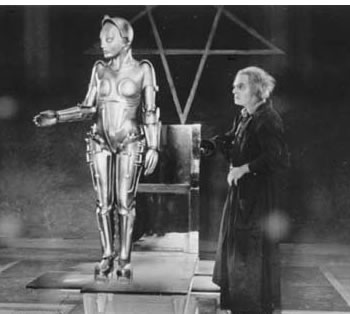Science Fiction
Dictionary
A B C D E F G H I J K L M N O P Q R S T U V W X Y Z
HRP-4C Robot Woman Is A Cybernetic Humanoid

HRP-4C is a robotic woman just unveiled to reporters in Tsukuba City (northeast of Tokyo) Japan. This cybernetic human sells for about $200,000.
Developed at the National Institute of Advanced Industrial Science and Technology, the HRP-4C female robot is able walk and follow some basic commands. The robotic woman is about the same size as an average Japanese young woman, at a height of 158 centimeters; it weighs just 43 kilograms (including battery).
Thirty motors in the body help it to walk and move about; eight motors power facial expressions.
Take a look at HRP-4C in the video below.
(HRP-4C robotic woman video)
Besides walking, the female robot is able to use facial motions and arm movements to indicate basic emotions, such as anger and surprise.
Despite the fact that this robot is clearly the creation of engineers (as opposed to artists who might provide this device with a greater semblance of feminine gesture and movement), it still makes me think of Fritz Leiber's mechanical bride:
Streamlined, smooth-working, absolutely noiseless, breath-takingly realistic. Each one is powered by thirty-seven midget electric motors, all completely noiseless, and is controlled by instructions, recorded on magnetic tape, which are triggered off by the sound of your voice and no one else's. There is a built-in microphone that hears everything you say, and an electric brain that selects a suitable answer. The de luxe model is built to your specifications, has fifty different facial expressions...
Fans of early cinema might also remember the female robot from Fritz Lang's 1927 classic Metropolis.

(Female robot from Fritz Lang's Metropolis)
Take a look at some of this robot's rivals:
- Actroid DER2 Late Model Fembot
- E.M.A. Robot Eternal Maiden Actualization Video
- Actroid DER2 Gets TV Commercial Gig Video
- Palette Super Model Robot
- Aiko Fembot No Stepford Wife
From BBC; thanks to Zac for pointing this one out.
Scroll down for more stories in the same category. (Story submitted 3/16/2009)
Follow this kind of news @Technovelgy.| Email | RSS | Blog It | Stumble | del.icio.us | Digg | Reddit |
Would
you like to contribute a story tip?
It's easy:
Get the URL of the story, and the related sf author, and add
it here.
Comment/Join discussion ( 8 )
Related News Stories - (" Robotics ")
Artificial Skin For Robots Is Coming Right Along
'... an elastic, tinted material that had all the feel and appearance of human flesh and epidermis.' - Harl Vincent (1934)
Robot Guard Dog On Duty
I might also be thinking of K-9 from Doctor Who.
Wearable Artificial Fabric Muscles
'It is remarkable that the long leverages of their machines are in most cases actuated by a sort of sham musculature...' HG Wells, 1898.
Dancing Robots Taught Dance Moves
'A clockwork figure would be the thing for you...' Jerome K. Jerome, 1893.
Technovelgy (that's tech-novel-gee!) is devoted to the creative science inventions and ideas of sf authors. Look for the Invention Category that interests you, the Glossary, the Invention Timeline, or see what's New.
Science Fiction
Timeline
1600-1899
1900-1939
1940's 1950's
1960's 1970's
1980's 1990's
2000's 2010's
Current News
Replace The Smartphone With A Connected Edge Node For AI Inference
'Buy a Little Dingbat... electropen, wrist watch, pocketphone, pocket radio, billfold ... all in one.'
Artificial Skin For Robots Is Coming Right Along
'... an elastic, tinted material that had all the feel and appearance of human flesh and epidermis.'
Robot Guard Dog On Duty
I might also be thinking of K-9 from Doctor Who.
Wearable Artificial Fabric Muscles
'It is remarkable that the long leverages of their machines are in most cases actuated by a sort of sham musculature...'
BrainBridge Concept Transplant Of Human Head Proposed
'Briquet’s head seemed to think that to find and attach a new body to her head was as easy as to fit and sew a new dress.'
Google's Nano Banana Pro Presents Handwritten Math Solutions
'...copy was turned out in a charming and entirely feminine handwriting.'
Edible Meat-Like Fungus Like Barbara Hambly's Slunch?
'It was almost unheard of for slunch to spread that fast...'
Sunday Robotics 'Memo' Bot Has Unique Training Glove
'He then started hand movements of definite pattern...'
Woman Marries Computer, Vonnegut's Dream Comes True
'Men are made of protoplasm... Lasts forever.'
Natural Gait With Prosthetic Connected To Nervous System
'The leg was to function, in a way, as a servo-mechanism operated by Larry’s brain...'
Spidery 'Walk Me' Toyota Autonomous Wheel Chair Like Star Wars
Walk along with the emperor.
Dancing Robots Taught Dance Moves
'A clockwork figure would be the thing for you...'
Proof Of Robothood - Not A Person
'Who are you people? - Show 'em.'
Indonesian Clans Battle
'The observation vehicle was of that peculiar variety used in conveying a large number of people across rough terrain.'
The 'Last Mile' In China Crowded With Delivery Robots
Yes, it's a delivery robot. On wheels.
Tornyol Microdrone Kills Mosquitoes
'The real border was defended by... a swarm of quasi-independent aerostats.'
